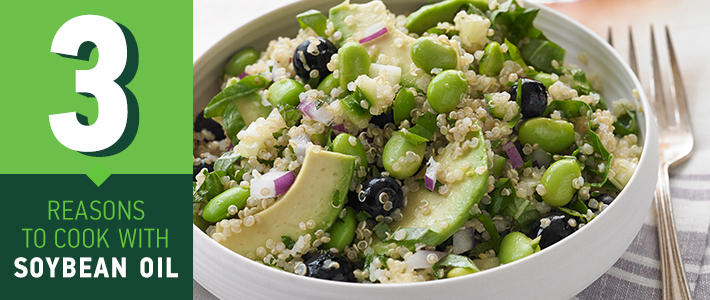
As many of you know, I love to cook and experiment with flavors from around the world. I’m fascinated by different flavor combinations and preparation methods, but at the same time, I am always looking for ways to boost the nutritional value in ethnic dishes.
If you are looking for ways to do this, let me introduce U.S. grown, heart-healthy soybean oil. Its neutral flavor makes it an adaptable ingredient to add to your favorite recipes and doesn’t take away from the taste of the dish. Soybean oil has unique beneficial qualities that I want to highlight:
1. Soybean Oil is Heart Healthy
People often don’t know that the FDA authorized the use of a qualified health claim confirming soybean oil may be able to reduce the risk of coronary heart disease. 1 Polyunsaturated fat provides both essential fatty acids: omega-6 fatty acids and omega-3 fatty acids.2-6
2. Soybeans are Environmentally Friendly
Soybeans are proudly grown in the U.S.7 and certified sustainable, thereby contributing to reduced transportation and a lower carbon footprint.8 The farmers are committed to methods of farming that preserve our land for future generations.
3. Soybean Oil is Versatile
Soybean oil’s neutral flavor can be easily paired with just about any ingredient. Some of my favorite uses include: sauces, dressings, baked goods and desserts. It pairs very well when used in combination with meat entrees.
One of my favorite summer recipes using soybean oil is the Super Soy and Ancient Grain Salad. Your family will be asking you to make this recipe for them again; it’s that good!
Super Soy and Ancient Grain Salad
2 tablespoons Soybean oil
2 Lemon, juiced and zested
2 teaspoons Dijon mustard
1⁄2 teaspoon Salt
1⁄2 teaspoon Ground black pepper
3 cups Cooked quinoa, cooled
2 cups Edamame, shelled and cooked according to package directions
1 cup Fresh blueberries
1 Cucumber, peeled and seeded (cut into 1/4-inch cubes)
1⁄2 cup Red onion, diced
1⁄2 cup Fresh basil, thinly sliced
1⁄4 cup Fresh mint, finely chopped
2 Ripe avocados (peeled, pitted, and sliced)
Instructions
- Whisk soybean oil, lemon juice and zest, and mustard in a small bowl until smooth; set aside.
- Combine quinoa, edamame, blueberries, cucumber, avocado, basil, mint and red onion in a medium serving bowl. Pour soybean oil lemon mixture over salad, tossing lightly, until combined. Top with avocado slices. Serve immediately.
If you love this recipe as much as I do, go to www.SoyConnection.com/recipes to find more delicious summer recipes.
I only endorse brands and products I love! All opinions expressed are my own. I received compensation to write this post in partnership with Soy Connection.
References
- U.S. Food and Drug Administration. “Soybean Oil and Reduced Risk of Coronary Heart Disease.” https://www.fda.gov/media/106649/download. July 31, 2017. Supportive but not conclusive scientific evidence suggests that eating about 1½ tablespoons (20.5 grams) daily of soybean oil, which contains unsaturated fat, may reduce the risk of coronary heart disease. To achieve this possible benefit, soybean oil is to replace saturated fat and not increase the total number of calories you eat in a day. One serving of this product contains 14 grams of soybean oil.
- USDA National Nutrient Database for Standard Reference.
- U.S. Department of Health and Human Services Food and Drug Administration. “Food Labeling: Nutrient Content Claims; Alpha-Linolenic Acid, Eicosapentaenoic Acid and Docosahexaenoic Acid Omega-3 Fatty Acids; Guidance for Industry.” January 1, 2016.
- “Omega-3 fatty acids.” http://umm.edu/health/medical/altmed/supplement/omega3-fatty-acids#ixzz2dygJvVyU. University of Maryland Medical Center. 2013.
- Harris WS, Mozaffarian D, Rimm E, et al. “Omega-6 fatty acids and risk for cardiovascular disease: a science advisory from the American Heart Association Nutrition Subcommittee of the Council on Nutrition, Physical Activity, and Metabolism; Council on Cardiovascular Nursing; and Council on Epidemiology and Prevention.” Circulation 2009;119:902-7.
- Johnson GH, Fritsche K. Effect of dietary linoleic acid on markers of inflammation in healthy persons: A systematic review of randomized controlled trials Journal of the Academy of Nutrition and Dietetics. 2012;1121029-41.
- “National Agricultural Statistics Service.” https://downloads.usda.library.cornell.edu/usda-esmis/files/j098zb09z/gb19f7847/ng451k91v/Acre-06-29-2018.pdf. United States Department of Agriculture. June 29, 2018.
- United Soybean Board. http://unitedsoybean.org/media-center/issue-briefs/sustainability/.
- “Soil Tillage and Crop Rotation.” https://www.ers.usda.gov/topics/farm-practices-management/crop-livestock-practices/soil-tillage-and-crop-rotation/. United States Department of Agriculture Economic Research Service. April 4, 2017.

